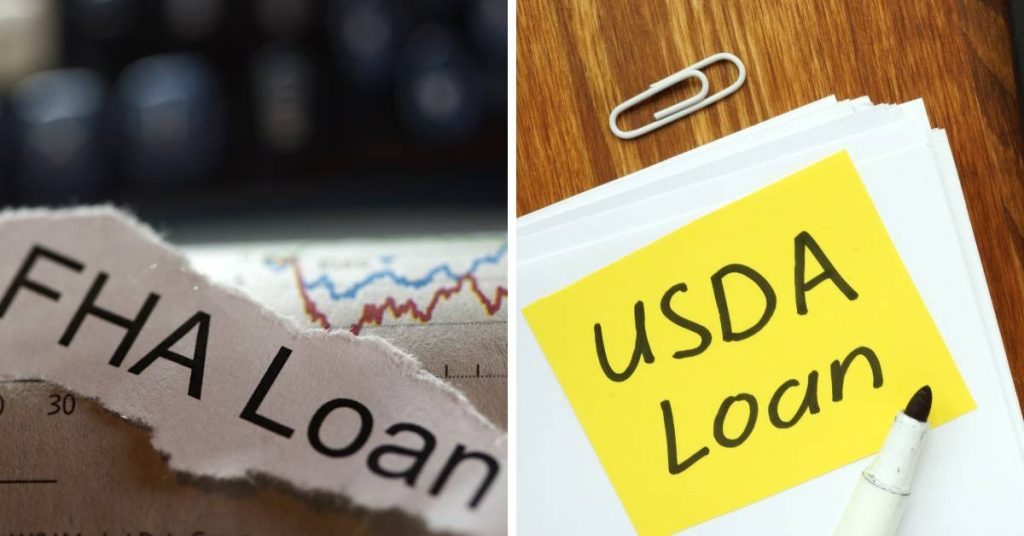Buying a home is one of the biggest decisions in anybody’s life. And for some of us who may not have a stellar credit score or loads of money saved up for a down deposit, getting a mortgage to buy a house can seem almost out of reach.
Luckily, USDA and FHA loans make homeownership possible for most.
This article will explore both loan types and will help you understand the differences and similarities between them. By the end, you should have a clear understanding of which loan is most suitable for you.
USDA Loan vs. FHA Loan
While both loans are government-backed, which is what allows them to have more flexible requirements, they have marked differences.
Let’s get into what these loans actually are.
USDA Loan
USDA loans are part of the USDA Rural Development Guaranteed Housing Loan Program that was created in 1949 as part of the American Housing Act.
These loans are aimed at increasing homeownership in rural and suburban areas, and making homeownership available for people with low or moderate income.
One of the best features of this loan is that it is a no-down-payment loan. USDA loan requirements are also generally more flexible than conventional loans.
Here are some of the types of USDA loans and how they work:
- USDA guaranteed loan – This is the most popular USDA loan. This loan is government-backed and is available to homeowners through mortgage lenders.
- USDA direct loan – This loan is meant for low and very-low-income earners who could not get a mortgage otherwise. Unlike USDA-guaranteed loans, you will need to apply directly to the USDA to get this loan.
- USDA home repair loan – This loan is meant to be used by homeowners to repair or upgrade their homes and is capped at $40k.
- USDA construction loan – This loan allows a homeowner to build their home and combines the cost of construction and the value of the home into one loan. There are additional requirements for this loan concerning the construction of the home.
FHA Loan
FHA loans are backed by the Federal Housing Administration. This government backing protects lenders against loss if homeowners default on their loans.
These loans are particularly popular with first-time homebuyers because they offer flexible credit scores and down payment requirements, while still being able to offer competitive interest rates.
You might even be able to get an FHA loan if you have been through Chapter 13 bankruptcy or other financial strife.
There are numerous FHA loans. Here are just a few:
- Basic FHA mortgage 203(b) – Like the USDA-guaranteed loan, this is by far the most popular FHA loan. It has fairly low credit and down payment requirements, and offers competitive interest rates as compared to conventional mortgages.
- FHA 203(k) loan – Otherwise known as a rehab loan or renovation loan, the 203(k) loan allows you to combine the price of the property and the cost of renovations into one mortgage with one monthly payment.
- Energy efficient mortgage – This loan covers not only the cost of the property, but also covers an additional ‘energy package’ that homeowners use to make their home more energy efficient.
- Home equity conversion mortgage – This is aimed at homeowners over the age of 62 who would like to give up some of their equity for cash.
What Is The Difference Between USDA Loans and FHA Loans?
Now let’s compare the USDA loan to the FHA loan.
Income Limits
USDA
- The 2024 income limit for a 1-4 member household in most areas is $103,500
- The 2024 income limit for a 5-8 member household in most areas is $136,600
- The income limit for direct loans will be lower
FHA
- There are no income limits
Credit Requirements
USDA
- While there is no official credit score requirement with USDA, most lenders require a 620.
- For a guaranteed loan, a credit score of 620 or higher is usually required by lenders.
- For a direct loan, you will still be considered with a lower score or even no score.
FHA
The general credit score requirement is 500 and above. Your credit score will largely determine your down payment.
Down Payment Requirements
USDA
- There is no down payment requirement – 100% financing
FHA
- For a credit score between 500 and 579 your down payment will most likely be 10%
- For a credit score of 580 or above, your down payment will most likely by 3.5%
Loan Limits
USDA
- Loan limits can go up to $386,400, but can vary depending on the state you’re in
FHA
- Loan limits can go up to over $1m but vary as well depending on the state you’re in
Property Requirements
USDA
- Must be homeowner’s primary residence
- Property must be safely accessible
- Property must be structurally sound
- Property must have functioning heating, cooling, and electrical systems
- Property cannot be primarily income-producing
FHA
- Property must be safe and secure
- Property must be structurally sound
- At least one unit on the property must be the homeowner’s primary residence
Benefits of USDA Loan vs. FHA Loan

Now that we have a clearer idea of the differences between the two loans, let’s talk about the benefits of each loan type.
USDA Loan Benefits
- This is a 100% financed loan with no required down payment.
- This loan has no official credit score requirement. You can get qualify for this loan without a credit score.
- There is no set loan limit.
- This loan generally offers lower interest rates than conventional loans.
- You can refinance a USDA loan to get better rates and terms.
FHA Loan Benefits
- This loan has more flexible credit score requirements.
- A short time-period after bankruptcy or foreclosure before you can qualify for the loan.
- Low down payment requirement.
- There is room to negotiate for the seller to cover up to 6% of the closing costs.
- Available in all of the U.S. and its territories, unlike the USDA loan.
- You can refinance an FHA loan to get better rates and terms.
As you can see, both these loans have very strong benefits.
If you live in a rural area and do not want to pay a down payment, a USDA loan may work better for you.
If you live in a densely populated city and need more flexible requirements than a conventional loan would offer, an FHA loan might be the more suitable option for you.
USDA Loan vs. Conventional Loan
If you think you might want to apply for a USDA loan, it’s important to also look at what conventional loans can offer you and compare the two, to ensure you are making the best decision for you.
Characteristics of a Conventional Loan
A conventional loan is a loan that has no government backing and is offered by private lenders.
The general credit score limit is 620 and you are expected to have a DTI lower than 50%.
Keep in mind that these factors, along with others like your income, will determine the interest rate, down payment requirement, and loan amount offered by lenders.
Differences between USDA loans and conventional loans
- Geographical limits – Your property must be in a USDA-eligible area to qualify for a USDA loan. There is no geographical limit for a conventional loan.
- Property use – For a USDA loan, your property must be your primary residence and must not be primarily used for commercial purposes. Conventional loans do not have these restrictions.
- Loan Limits – USDA loans do not have set loan limits. Conventional loans have loan limits.
- Income Limits Your household must earn below the USDA income limit in your area to qualify for a USDA loan. Conventional loans have no income limit.
- Terms – Because a USDA loan is government-backed, lenders are generally more flexible with their requirements and terms, and generally offer lower interest rates than you would get with a conventional loan. USDA loans also do not require down payments while conventional loans do.
- Application processing time – Because USDA loans need to be approved by both the lender and USDA, the application process for this loan may take slightly longer than the application process for a conventional loan
First-Time Home Buyer vs. USDA Loan

If you live in a rural area and you want to buy your first home, a USDA loan could be a great option for you.
Some of the benefits that make a USDA loan great for first-time home buyers include:
- 100% financing – This means you do not have to have a down payment saved up.
- Flexible credit requirements – While you may need a credit score of 620 or above to have your loan underwritten automatically, you can still get a USDA loan with a lower credit score and have your loan underwritten manually.
- Closing cost flexibility – USDA loans allow lenders to cover up to 6% of closing costs which means if they are able to negotiate for the lender to cover some of those costs, first-time homeowners do not need to have all the money for closing costs already saved up
However, like all loans, USDA loans have their limitations. If you are a first-time homebuyer living in an urban area, there is a chance a property in your area is not eligible for a USDA loan.
You may also not be eligible for a USDA loan if you earn above the USDA established income limits.
Conventional Loan vs. FHA Loan vs. USDA Loan
We have made a lot of comparisons between these three loans.
This table puts it all together. Use it to see which loan ticks all your boxes.
Which Loan Should I Choose?
There are a lot of considerations when selecting which type of loan works best for you.
Hopefully, after going through this article, you have a better idea of the benefits and requirements of each loan.
When you think you know which loan you want to apply for, find out the requirements from your local lender, get started on your application, and begin your journey to homeownership today.
Frequently Asked Questions
What is the downside to a USDA loan?
Some of the downsides of a USDA loan include geographical restrictions, income limits, and property use restrictions.
Is USDA or FHA easier to get?
The answer to this depends on which one you qualify for. If, for example, you do not have a lot of money saved up for a down payment, a USDA loan may be easier for you to get. Likewise, if you have a credit score in the 500s, an FHA loan may be easier to get.
Keep in mind that a USDA loan may take longer to process than an FHA loan. This is because a USDA loan needs to be underwritten by both the lender and the USDA.






